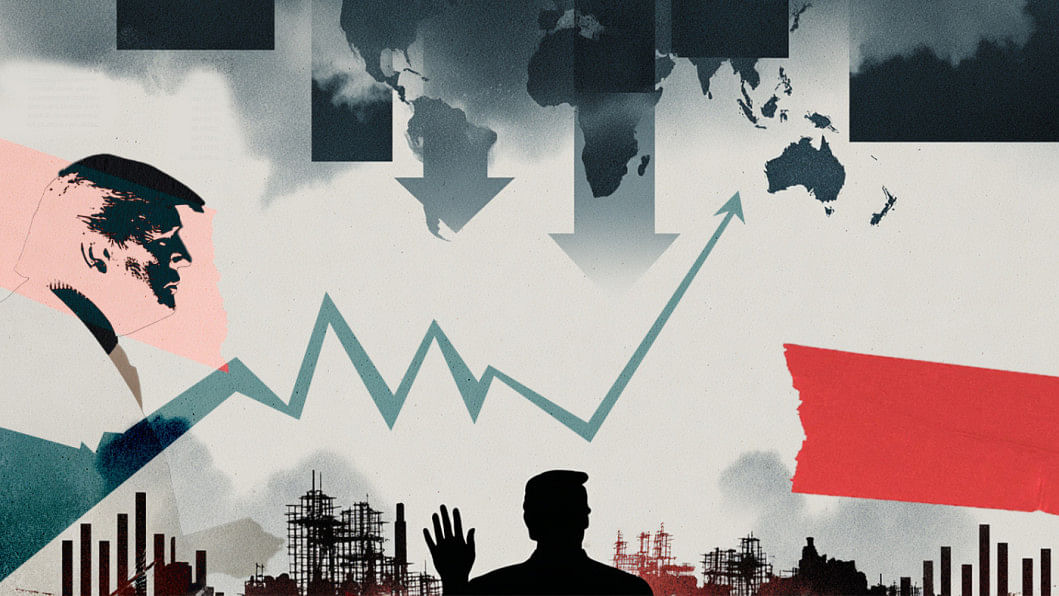VISUAL: SALMAN SAKIB SHAHRYAR
“>
VISUAL: SALMAN SAKIB SHAHRYAR
The US has long been looking to put a brake on China’s trade dominance that has greatly overtaken the future of manufacturing in many developed countries since it was granted accession to the World Trade Organization (WTO) in 2001. It has also been long overdue for the US to put a brake on the growing fiscal and trade deficits that threaten the sustainability of American debt management. The tariff war, despite its various criticisms, has turned out to be inevitable for the Trump regime to check both China and the growing deficits. This piece is not an attempt to justify the Trumpian tariff wall that most open market economists oppose, but it is an attempt to see which economics drives President Donald Trump to resort to massively using tariff hikes across the board.
China embarked on opening its economy in the late 1970s. It was the 10th largest economy in 1981 and sixth in 2001. The next decade was magical for China, which became the second largest economy in the early 2010s, securing almost an $8 trillion economy while the US economy was then almost $16 trillion. In the following 10 years, China kept chasing the largest economy in the world. By 2021, China’s GDP worth nearly $18 trillion became 75 percent of the US economy, which was valued at around $24 trillion. If one can videotape this comparative race, the US has every reason to fear China’s pace since it is likely to outsize the US GDP soon.
The vital channel of China’s rapid growth has been trade, where the country is accused of using predatory prices and keeping its currency value artificially low enough to gain faster export growth to restrain import growth. In 1986, China ranked only 15th in the volume of exports to the US. It was able to elevate itself to the 10th position within two years, and to the fifth position within three years after that. However, it took China 10 years from 1991 to 2001 to become the fourth largest exporter to the US. Only Canada, Mexico, and Japan were ahead of China at that time. China beat Japan and became the third largest exporter to the US by 2002, the second largest by beating Mexico by 2003, and finally seized the top position in 2007. Trump’s tariff war is a deliberate way to put a lid on this export expansion by China.
There is a notable quote by Benjamin Franklin, one of the founding fathers of the US, “Rather go to bed without dinner than to rise in debt.” And that was the economic philosophy most American leaders believed in. But now the amount of debt is more than $36 trillion for a nearly $30 trillion economy, raising the debt-GDP ratio to as high as 121 percent—which was just 31 percent in 1981 and 54 percent in 2001. Although the debt-GDP ratio for countries like Japan is as high as 256 percent, the US does not want to be like Japan, which kept losing its global dominance since the country began to plunge into debts in the 1990s.
Debt is like the level of water in a bucket while deficits are the drops of water that fall into the bucket from a faucet. Debt is a concept of “stock” while deficits are akin to “flow.” Repayments of debt are akin to “flow” too. Say, there is a leak in the bucket which is like repayments of debt. If the faucet’s dripping of water is equal in amount to the drained water, the water level remains the same, suggesting that the debt-GDP ratio is constant or stable. But most developed countries cannot afford that luxury. Rather, most nations experience fiscal deficits that outweigh repayments, making a steady uptrend in the debt-GDP ratio. While economists have benchmarks for inflation, unemployment, and many other macro aspects, the determination of a safe threshold for debt is still undecided in macroeconomics. However, exceeding 100 percent is seen as a sign of potential danger, which the US touched in 2012, and global agencies began to downgrade its country ratings ever since.
The above-mentioned analogy clarifies that reducing debt entails two steps: 1) reduce fiscal deficits; and 2) increase debt repayments. When the second one is tough, the regime can concentrate on raising revenue collection. The equation of macro balances unveils that a growing trade deficit has often been associated with a growing fiscal deficit. Say, the government has taken a project to make a big bridge. The authority issues a bond to borrow the money, which we call deficit financing. Now the government imports steel and equipment more than what it can export, registering a trade deficit.
The emergence of these two types of deficits is often termed as the “twin deficits,” which the US experienced in the 1980s following the tax cut by the Reagan administration. President Trump’s tariffs are an attempt to address the twin deficits as well. US trade deficits have reached almost $800 billion while fiscal deficits have touched $1.83 trillion in 2024. Trade deficits can be reduced by two policy tools: 1) the exchange rate depreciation; and 2) tariff hikes. For a country like the US where the government has no control over its currency’s value, since it is fully market determined, the first option is blunt. That is why the US has moved to the second option of raising tariffs to discourage imports and thus improve the trade balance.
Collecting tariffs is an effective way to increase revenue and dampen fiscal deficits. Thus, tariffs reduce the twin deficits, although higher tariffs are likely to reduce GDP growth as well. US Treasury Secretary Scott Bessent recently said the country could collect $300 billion in tariff revenue this year. The Congressional Budget Office (CBO) has estimated that the tariff income will total about $2.8 trillion over the next 10 years—more than double the usual figures. Revenue collection has been 111 percent higher than last year’s collection up to early July. The increase will more than double when tariffs on all countries begin to be effective from August this year.
Based on the deeper economics of Trump’s tariff war—related to China’s trade expansion and the US’s incredible debt burden—there is little chance that simply dialogues between statesmen will be able to convince Washington to bring their tariffs down.
Dr Birupaksha Paul is professor of economics at the State University of New York in Cortland, US.
Views expressed in this article are the author’s own.
Follow The Daily Star Opinion on Facebook for the latest opinions, commentaries and analyses by experts and professionals. To contribute your article or letter to The Daily Star Opinion, see our guidelines for submission.




 For all latest news, follow The Daily Star’s Google News channel.
For all latest news, follow The Daily Star’s Google News channel. 


